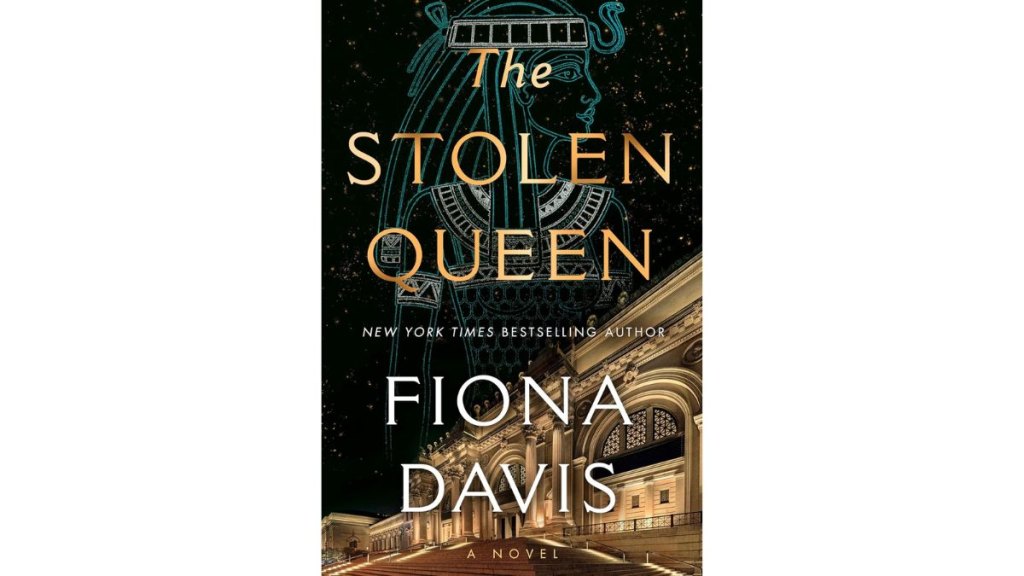Beloved for her glamorous, dual-timeline historical fiction novels, New York Times bestselling author Fiona Davis has written eight novels—and each of her stories is set in iconic New York City landmarks from The New York Public Library to Radio City Music Hall and beyond. Her latest book, The Stolen Queen, begins at the Metropolitan Museum of Art in 1978 before taking readers to Egypt in the 1930s. Ahead of the book’s release, First for Women’s Editor-in-Chief, Liz Vaccariello, sat down with Davis to discuss The Stolen Queen—which Davis describes as “a cross between Thelma & Louise meets Indiana Jones meets The Devil Wears Prada”—plus, what she thinks readers will enjoy most about the story, her health journey after being diagnosed with Parkinson’s and more. Check out the exclusive video interview above!
Then, keep scrolling for part two of the exclusive excerpt, which reveals what Charlotte may have just discovered. (Missed part one of the excerpt? Read it here!)
Part Two: An exclusive look at ‘The Stolen Queen’

Chapter 1 cont. / New York City, 1978
Charlotte paused in front of one of her favorite depictions of the female pharaoh Hathorkare in the Metropolitan Museum of Art, a fragment of a statue known as the Cerulean Queen. While many of the other figures from Egypt were made of limestone or red granite with a rough finish, the Cerulean Queen was made of finely polished lapis lazuli. The only remnant of the statue was a tantalizing fragment of the lower portion of its head, consisting of the cheeks, the chin and a large portion of the lips. And what lips they were: beautifully curved and utterly sensuous. The lips of Hathorkare. If the rest of the statue came anywhere close to being as beautiful as the lips, it must have been a sight to behold. Charlotte wondered how it came to be smashed. Was it accidentally dropped while being moved from one location to another? Or did someone take a hammer to it on orders from Saukemet II? The thought was too awful to contemplate.
The fragment was small, only around five inches across. It had been found at the turn of the twentieth century, by a British earl who fancied himself something of an Egyptologist, in a trash heap containing destroyed statues of Hathorkare, just outside her temple. Nearby had lain a broken slab of limestone with a warning that translated to “Anyone who removes an object dear to Hathorkare outside of the boundaries of the kingdom will face the wrath of the gods.”
The earl was killed in a hunting accident two weeks after bringing the Cerulean Queen to his estate in Hampshire. His widow quickly sold it off to the Met and died less than a month later choking on a gumdrop.
The curse of Hathorkare hadn’t ended with the death of the earl’s widow. Charlotte had fallen under its spell as well.
It was dangerous to think about that time.
Charlotte took a couple of deep breaths, studying the curve of the statue’s chin, trying to imagine the shape of the nose and eyes. The Cerulean Queen gave her hope. Hope that one could be broken and crushed and still carry on, the gleaming remnant proof that something beautiful once existed in this terrible world.
She headed downstairs, where Frederick and several others from their department stood around a large worktable in the storeroom, one of many bursting with artwork and sculptures in the Met’s basement level.
“Ah, Charlotte. I know you’ll want to see this,” said Frederick, waving her over. Whatever lay on the table was hidden due to the crush of bodies surrounding it. “We’ve just received a very generous one‑year loan from an anonymous donor.”
Frederick usually consulted with Charlotte on any loans. Why now, when they had their hands full managing the loans for the King Tut exhibition, would they need one more? Typical Frederick, to have his attention pulled by the latest shiny new thing. She hoped it was worth it as she maneuvered her way closer.
But once she was at the edge of the table and the object came into focus, she gasped, one hand going to her heart. The conservators on either side of her looked at her curiously.
In the middle of the table lay a broad collar, a type of necklace popular in ancient Egypt. But this one was exquisite, made of gold and glass, and Charlotte knew even before she leaned in closer that she would find a gap on the right side of the bottom row where one of the nefer amulets was missing.
The piece was exceptional, distinctive.
She’d first seen it in Egypt, in 1936, when it was lifted from the bowels of a tomb, covered in dust.
And she’d last seen it a year later, right before it was lost at the bottom of the Nile. She’d been 20 years old.
“Does it have the cartouche of Hathorkare on the back of the clasp?” she asked, not bothering to hide the panic in her voice.
“It certainly does.” Frederick nodded to the technician, who turned over the necklace with gloved hands to show off the hieroglyphics that represented the pharaoh’s name, enclosed in an oval.
“I’m impressed.”
“Where did this come from?” she demanded.
“Charlotte, are you all right?” Frederick regarded her with concern. “You’re as white as a sheet.”
She had so many questions, the words got stuck in her throat. “Why are we getting it? Who was the donor?”
“The donor asked to remain anonymous. We have the broad collar for one year. I thought you’d be pleased.”
She could almost hear the screams from that fateful night echoing in her head. The night that changed everything. And the reason she could never return to Egypt.
Frederick ordered the technicians to take the necklace away and turned to leave. Charlotte followed him out the door.
“You have to tell me who the donor is,” she said. “It’s important.”
Frederick looked at his watch. “I have exactly four minutes until my next meeting at the other side of the building. Why exactly do you need to know this information?”
She couldn’t tell him. That would reveal too much, and she was barely hanging on as it was. “I was there when it was found.”
“Ah, back in Egypt, in the olden days.” He laughed at his joke. Charlotte did not. “What does it matter who owns it now?”
“It doesn’t make sense, how it suddenly reappeared like this. It was lost.”
“Then lucky for us it was found. I would think you would be pleased.”
Far from it. But Charlotte had to find out where the broad collar came from, how it got to the Met.
And why it was haunting her from the grave.
To read the whole story, preorder your copy of The Stolen Queen (out 1/7) now!
Adapted from THE STOLEN QUEEN by Fiona Davis. To be published on January 7, 2025 by Dutton, an imprint of Penguin Publishing Group, a division of Penguin Random House LLC. Copyright © 2025 Fiona Davis




